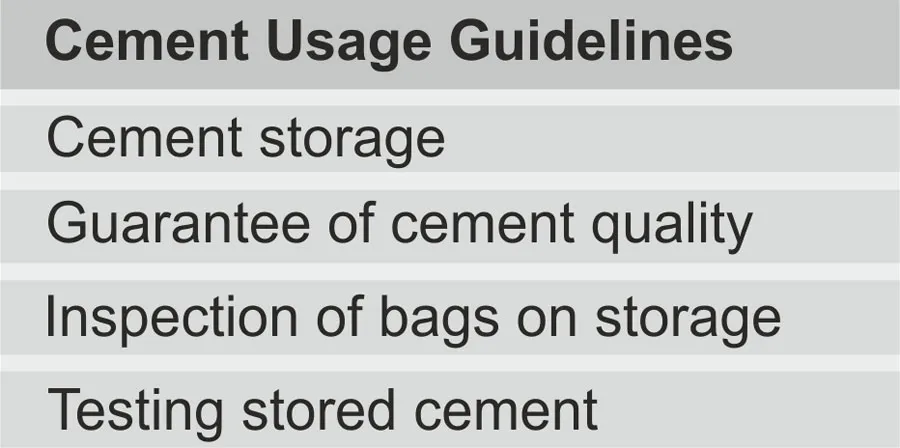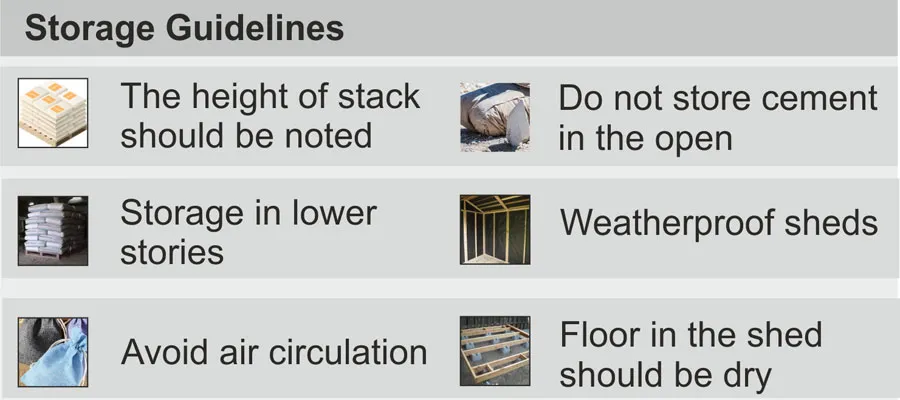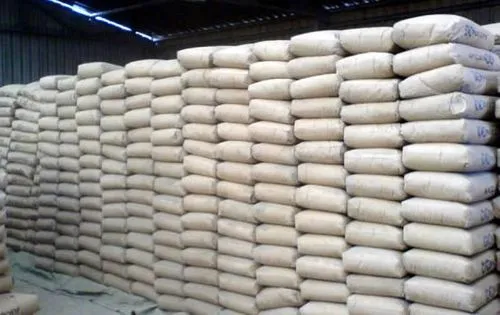There are doubts in the minds of construction professionals regarding storage of cement, duration of storage, cement storage guidelines and recommendations on ways to evaluate storage of cement and its usage.
This subject is not new as many construction professionals are aware of it and there are inputs through much academic literature on the subject, Bureau of Indian Standard codes and experts’ views.
Concrete is used for its compressive strength. If cement does not hydrate on exposure to moisture or water the very purpose of usage of cement in concrete is defeated as it is through reaction of cement and water which is known as hydration through which concrete gains compressive strength .
A. We are emphasizing few clarifications on the subject, already known to construction professionals in this write up.
- Cement storage Cement can be stored for upto 3 months before usage as per codal provisions. As per codal provisions, cement stored beyond 3 months can also be used but it need to be retested before use and shall be rejected if it fails to confirm to any standards If the cement is stored properly and cement has not been exposed to moisture or dampness, one can confidently use the cement for the works.
- Guarantee of cement quality The Cement manufacturer can guarantee the quality of cement, which is stored as per standard guidelines mentioned by Bureau of Indian Standards.
- Inspection of bags on storage If there are lumps, which could be broken by hands, it clearly indicates that the storage of cement is in the open, moisture or dampness would have affected the quality of cement and that would have led to partial lumps. If hands can break the lumps the cement can be used. This is because cement has not reacted with water and hence no hydration has taken place. However if the bags are fully clotted or granulated this could be because of exposure of either moisture or water with cement as cement is hygroscopic. This hygroscopic nature of cement is an indication of its affinity to water which leads to hydration of cement thereby leading to hard lumps in cement bags or in extreme cases the full bag is hardened and cake like phenomenon is seen. If lumps are soft and breakable the cement can be used. If hard, the lumps may be removed by screening and the reclaimed cement sent for testing.
- Testing stored cement If there is suspicion on the quality of cement after prolonged storage then either the cement can be tested or one can adopt a practical site trial of casting concrete cubes using the standard recommended proportions and check the concrete compressive strength of cubes for the desired period – 1 day, 3 days or 7 days.

B. Cement storage guidelines as per IS 4082
IS 4082-1996 laid down the stipulation for storage of cement as follows:
- The height of stack shall not be more than 10 bags to prevent the possibility of lumping up under pressure.
- Do not store cement in the open. Under exceptional conditions, cement can be stored on a raised damp proof floor and covered with tarpaulins on the top and sides. Ensure that rain water does not stagnate on the tarpaulin. Storage in the open should be limited to the minimum possible time i.e. about 48 hours.
- On building contracts, lower stories and other completed portions of buildings may be used for cement storage. In such cases cement should be protected from rain that may blow in through the openings. Also protect cement from water dripping from curing or other operations in the upper floors.
- Normally store cement in weatherproof sheds.
- The floor in the shed should be dry and raised at least 150 mm from ground level.
- Place the bags tightly together to avoid air circulation.

C. Method of testing Cement for freshness as per IS code
Loss on Ignition test is a cement test recommended as the codal provisions to evaluate the freshness of cement which helps us to understand if the cement is adulterated with moisture or any other impurities. Here 1 gram of cement sample is heated to a temperature between 900 to 1000 C and the loss in weight is measured.
Owing to the presence of sulphide in slag cements which may be oxidised to sulphates, there may be a gain instead of loss in some cases and this should be reported.
As per the respective codes, for OPC 53 grade, the Loss on ignition value must not exceed 4%, whereas for PPC, PSC, SRC and Rapid hardening Portland cement it must not exceed 5%
All the above guidelines have been outlined in the respective codes for so many years. The responsibility of proper storage of cement therefore lies with the user.
Issued by Institutional Organisation with inputs from Ramco Cements Ltd.

